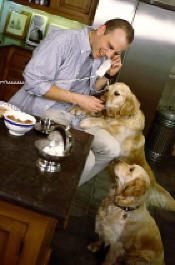|
Need Help?
|
|
Call
1-800-372-3706
to
speak to a Veterinary Behavior Technician |
|
Paws To Speak!
Member
Main Menu
|




|
 |
|
Help is at your
fingertips by library, email and
phone. |

Click on
Library Icon
to learn more
|
Putting
Treats into Medical Treatment
Pets need
medicine but don't want always want to take it.
According to Dr. Marty Becker,
one poll showed that only 10 percent of cat
owners and 30 percent of dog owners succeed in medicating their pets
correctly. That means prescriptions sent home by the veterinarian end up in
the cupboard rather than inside the pet. The pet owner may be too
embarrassed to go back to the veterinarian and report failure to give the
medication.
When pet parents
are unable to
give
medications, at
precise intervals,
for as long as the
veterinarian has
prescribed, the
pet's recovery may
be compromised.
What NOT to do?
Do not ambush (surprise) your dog by prying his mouth open
and trying to shove the pill down his throat. From your dog's point of view,
you have just become somewhat of a threat. The dog will not know how to
predict when you will suddenly "attack" in this manner. When prying your
dog's mouth open comes out of nowhere, you risk a negative emotional impact
on the dog and your relationship.
What TO do?
Although pet
medications can now
be disguised inside
of tasty coverings
called "pill
pockets" some pets
are savvy enough to
find the pill and
spit it out. Some
medications can also
be compounded into
flavored chewable
tablets or liquids.
Although a step up
in making medicine
taste better, some
pets will still
reject the flavor or
texture of these
mixtures.
If your pet is fussy, a good strategy is to use the pet's favorite food
in a 3-Step approach.
Try a 3-Treat approach:
- Give your pet the first, small piece of food (kibble
size) with no pill inside. Show your pet a
larger piece of the food (1/2 slice of bread, 2 oz of meat,1/2 hot dog
size)
- Then, with one hand give your pet the second, small piece
of food with the pill inside.
-
Immediately, offer the third,
larger piece of food with your other hand. The goal is for the
dog to gobble down the smaller second treat to get to the larger third
treat. You want your pet to
swallow the second treat rather
than inspect and spit it out after realizing the pill is inside. Many
dogs learn how to spit out the pill and swallow the treat.
Teach a 6-Step "swallow" cue:
If the 3-Treat approach does not work then take a more direct approach.
Do not resort to ambushing your dog with brawn. Instead, engage your dog's
brain. Help your pet to learn that taking medications has a big pay off.
Make sure you stay positive and relaxed. If you are tense, your dog is more
likely to become tense. Dogs read our body language.
- Bring out your pets favorite food.
- Cover the pill in tasty, slippery butter.
- Then, show your pet the pill and the favorite food.
- Give the pet the cue word, "swallow" as you gently open the pet's
mouth and put the buttery pill on the back of the tongue.
- Gently close the mouth and rub the pet's the neck as you encourage,
"swallow" in a calm, happy tone.
-
The second after the pet swallows
the pill, begin profuse praise and deliver the big "pay out" of the
pet's favorite food.
Be Patient
Don't expect your pet to understand the "swallow" cue right away. Dogs
need repetition to understand new words and routines. Therefore, follow the
6-Step routine EVERY time you need to give your pet a pill. Your pet will
learn to accept the drill to get the pay off. Giving your pet clear routines
helps your pet cooperate and trust you. The relationship is enhanced by
helping the pet understand you are taking a leadership role but doing so in
a predictable, gentle manner.
Make it Special
What's important is to use a food treat that is novel and highly
desirable from your pet's point of view. Consider Farmer John's Liverwurst,
hot dogs, cheeses, breads, peanut butter, or any cooked meat. Find out what
makes your dog do back flips and use that treat for the least desirable
actions you ask your dog to do.
Remember, the pet is always
wondering, "What's in it for me?" Answer that question in your pet's
mind when you want your pet's cooperation and you are likely to get it. If
your pet is not food motivated then pick another big pay off like a new toy,
a long massage or an interesting excursion.
|